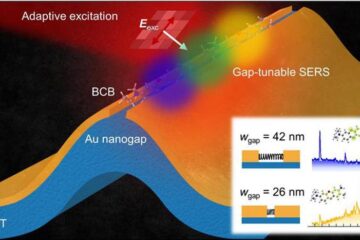Major mutations, not many small changes, might lead way to new species

Hummingbirds visited nearly 70 times more often after scientists altered the color of a kind of monkeyflower from pink – beloved by bees but virtually ignored by hummingbirds – to a hummer-attractive yellow-orange.
Researchers writing in the Nov. 13 issue of Nature say perhaps it was a major change or two, such as petal color, that first forged the fork in the evolutionary road that led to today’s species of monkeyflowers that are attractive to and pollinated by hummingbirds and separate species of monkeyflowers that are pollinated by bees.
The color change is the result, it appears, of mutation in a single gene, according to H.D. “Toby” Bradshaw, a professor of biology at the University of Washington and lead author of the Nature piece. He says the resulting quick change in pollinator preferences adds to the debate over whether new species arise according to the classic, 150-year-old Darwin theory of evolution that says it may take a hundred small genetic changes, each with mounting effect, or might speciation be kick-started by a few mutations that cause large effects.
“It could be that the first adaptations require a few big changes, sort of like taking a watch that has stopped ticking and banging it a few times before making the small tweaks to restore its optimal performance,” says Douglas Schemske, professor of plant biology at Michigan State University and co-author of the letter in Nature.
There are 123 species of monkeyflowers, a wildflower found around the world. Mimulus lewisii appeals to bees with forward-thrusting petals that serve as a landing platform and yellow nectar guides that contrast with the pale pink flowers. The closely related M. cardinalis, on the other hand, has a deep, tubular shape that excludes bees but is easily probed by the slender beaks of hummingbirds, and has red or deep yellow-orange petals, colors bees can’t see.
These and other differences make the species of monkeyflowers distinct and nearly eliminates crossbreeding in the wild.
In an experiment funded by the National Science Foundation, the researchers changed the region of a chromosome, thought to be a single gene, that affects the concentration of yellow pigment in petals of monkeyflowers. M. lewisii, the normal favorite of bees, responded with petals of yellow-orange instead of the usual pink. Although its other features – flower size, petal shape and amount of nectar – were unchanged, the resulting flowers were suddenly being visited 68 times more often by hummingbirds. The flowers were actually shunned by bees, probably because orange is in the spectrum of light they don’t see.
In another alteration as part of the experiment, M. cardinalis, usually favored by hummingbirds, responded with petals that were dark pink rather than deep red. These flowers appealed equally to hummingbirds and bees.
Bradshaw and Schemske say altering just the genetic region responsible for the concentration of yellow pigment is much like what might happen during a naturally occurring mutation.
“Perhaps a single mutation having to do with color changed the pollinator milieu back when there was only a single species,” Bradshaw says. That one big evolutionary step may then have been followed by many smaller steps triggered by pollinator preferences that led ultimately to different species.
Monkeyflowers, so-called because someone once imagined the face of a monkey in the markings on the blossoms, have been used by researchers interested in ecology and evolution for more than 50 years. The plants readily reveal the effects of crossbreeding and can be planted in native settings so they are useful for experiments.
“A unique aspect of out work is that it combines ecological observations with molecular genetic techniques to elucidate the process of adaptation in natural populations,” Schemske says.
Schemske, Bradshaw and researchers at Duke University, Clemson University, University of North Carolina and University of Montana recently received $5 million for the study of monkeyflowers and questions of how species arise. The money is part of the new Frontiers in Integrative Biological Research program .
For more information
Bradshaw, (206) 954-4392, toby@u.washington.edu (On Veterans Day, it will be best to call rather than use e-mail)
Schemske, (517) 432-5289, schem@msu.edu
Michigan State University media contact: Tom Oswald, (517) 432-0920, oswald@msu.edu
NSF’s Frontiers in Integrative Biological Research explores biology’s mysteries:
http://www.nsf.gov/od/lpa/news/03/pr03106.htm
Media Contact
More Information:
http://www.nsf.gov/od/lpa/news/03/pr03106.htmAll latest news from the category: Life Sciences and Chemistry
Articles and reports from the Life Sciences and chemistry area deal with applied and basic research into modern biology, chemistry and human medicine.
Valuable information can be found on a range of life sciences fields including bacteriology, biochemistry, bionics, bioinformatics, biophysics, biotechnology, genetics, geobotany, human biology, marine biology, microbiology, molecular biology, cellular biology, zoology, bioinorganic chemistry, microchemistry and environmental chemistry.
Newest articles

“Nanostitches” enable lighter and tougher composite materials
In research that may lead to next-generation airplanes and spacecraft, MIT engineers used carbon nanotubes to prevent cracking in multilayered composites. To save on fuel and reduce aircraft emissions, engineers…

Trash to treasure
Researchers turn metal waste into catalyst for hydrogen. Scientists have found a way to transform metal waste into a highly efficient catalyst to make hydrogen from water, a discovery that…

Real-time detection of infectious disease viruses
… by searching for molecular fingerprinting. A research team consisting of Professor Kyoung-Duck Park and Taeyoung Moon and Huitae Joo, PhD candidates, from the Department of Physics at Pohang University…





















